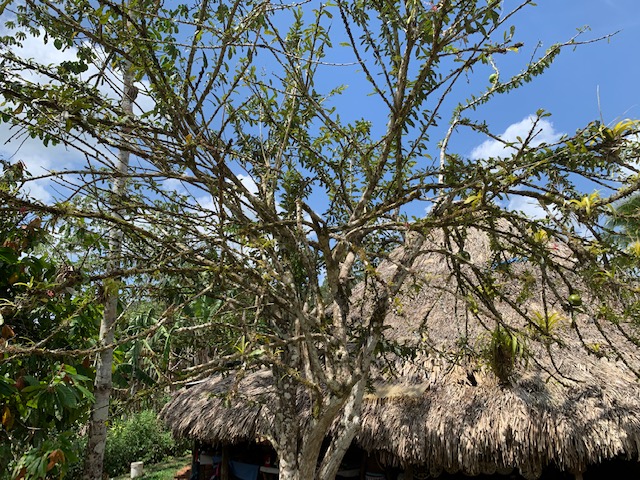I’m back,
First, Rob wants to correct his Trogan photo in the Pipeline Road blog. This was the Slaty-tailed and not the Collared Trogan. Oops! It was Héctor, our bird guide who corrected us. He reckons the dusting of white feathers under the sides of the black throat are just variations. He sees the female many times and she matches the slaty description.
Tuesday we walked the forest trail again, to the end this time, which comes out on the road past the US houses. We were HOT. Didn’t really see anything new, but a Toucan close up that flew off before Rob could point his camera.
. . . And this impossibly large gourd on a small tree. They are also called calabash - used for bowls and utensils and not edible.
This is another gourd tree. Can you spot them?
Editor's note: I saw these trees in Nicaragua and loved them. They are calabash trees and are pollinated by small bats. Not much is written about the Calabash tree (Crescentia cujete), commonly called Totumo in Panama. These trees are amazing because the gourds, the flowers that become the gourds, and the leaves grow out of the trunk and branches, as shown in the photo of Hansi with the gourd above, though unfortunately a background stick makes it look as though the gourd has a long stem. Below is a photo I took in Nicaragua of the fruits on the tree.
As Juan was pointing out the lichen on the trees, he casually mentioned that the bats are more active at night, and then we realized that the spots on the tree in front of us were not actually spots but bats. I don’t remember seeing them roost in that way anywhere else. These were quite small and I have since learned that they are the Greater Sac-winged Bat. Despite the name, they a very small.
April 5, today, we signed up for a tour we had been avoiding - to an Indigenous Village, fearing that it would be pretty Touristy”. Well it was, but we were able to learn about the kinds of goods and cloth made from the palm fibres and bark of trees. The dyes made from unripe fruit of the Jagua tree are used to decorate the skin in ceremonies (temporary) -- or permanent under the skin tattoos. Also as an insect repellent on babies. The ripe fruit is a diuretic, antibiotic, and can kill parasites. Sorry, no picture of the Jagua.
Editor's note: Oh yes there are pix of the Jagua, bless the Internet. The tree is called Jagua Genipa Americana, and Hansi and Rob can plant a live 2- to 6-inch one one in their yard for a mere $48.17 USD, shipped FREE to the U.S. mainland! . . . though I doubt the tiny thing would get past Canadian customs or survive a Canadian winter. Note that these fruits have blossom ends and stems and grow in clusters, unlike the gourds above.
Other dyes are made from several other plants and bark. All the goods sold are natural fibres and dyes.
The men and women danced for us, their beautiful handmade wares were for sale and a lunch of fish and plantain was served.








.jpg)








No comments:
Post a Comment